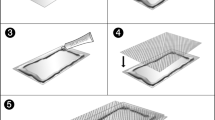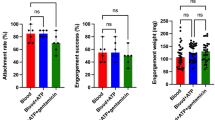Abstract
An artificial feeding device was constructed with a Baudruche, membrane bearing olfactory and tactile stimuli, to induce voluntary attachment and feeding of the brown ear tick,Rhipicephalus appendiculatus. Preparation of the membrane and experimental conditions used are described. Unfed adults ofR. appendiculatus, 2–3 weeks after moulting, were confined on the membrane, which was treated with cattle ear-wash and other stimuli. They attached and commenced sucking blood within 12–48 h. Fully engorged ticks started detaching from the membrane on the 6th day. After a 5–6-day incubation period, they started laying eggs which hatched into normal larvae.
Similar content being viewed by others
References
Allen, J.R., 1973. Tick resistance: Basophils in skin reactions of resistant guinea pigs. Int. J. Parasitol., 3: 195–200.
Arthur, D.R., 1970. Tick feeding and its implications. Adv. Parasitol., 8: 275–292.
Bailey, K.P., 1960. Notes on the rearing ofRhipicephalus appendiculatus and their infection withTheileria parva for experimental transmission. Bull. Epizoot. Dis. Afr., 8: 33–43.
Butler, J.F., Hess, W.R., Endris, R.G. and Holscher, K.H., 1982. In vitro feeding ofOrnithodoros ticks for rearing and assessment of disease transmission. In: D.A. Griffiths and C.E. Bouman (Editors), Proc. 6th Int. Congress of Acarology, Vol. 2, Edinburgh, UK, 1982. pp. 1075–1081.
Chabaud, A.G., 1950. Sur la nutrition artificelle des tiques. Ann. Parasitol. Hum. Comp., 25: 142–147.
DeMeillon, B. and Goldberg, L., 1947. Preliminary studies on the nutritional requirements of the bedbug (Cimex lectularius) and the tick (Ornithodoros moubata). J. Exp. Biol., 24: 41–63.
Gregson, J.D., 1960. Morphology and functioning of the mouthparts ofDermacentor andersoni Stiles. Acta Trop., 17: 48–79.
Gregson, J.D., 1967. Observations on the movements of fluids in the vicinity of the mouth parts of naturally feedingDermacentor andersoni Stiles. Parasitology, 57: 1–8.
Howarth, J.A. and Hokama, Y., 1978. Studies withOrnithodoros coriaceus Koch (Acarina: Argasidae), the suspected vector of epizootic bovine abortion. In: J.K.H. Wilde (Editor), Tick-Borne Diseases and their Vectors. Edinburgh University Press, Edinburgh, pp. 168–176.
Irvin, A.D. and Brocklesby, D.W., 1970. Rearing and maintainingRhipicephalus appendiculatus in the laboratory. J. Inst. Anim. Technol., 21: 106–112.
Irvin, A.D., Purnell, R.E. and Peirce, M.A., 1973. Some observations on the feeding behaviour of the tickRhipicephalus appendiculatus (Neumann, 1901) on cattle and rabbits in the laboratory. Trop. Anim. Health Prod., 5: 87–97.
Kemp, D.H., Koudstaal, D., Roberts, J.A. and Kerr, J.D., 1975. Feeding ofBoophilus microplus larvae on a partially defined medium through thin slices of cattle skin. Parasitology, 70: 243–254.
Mango, C.K.A. and Galun, R., 1977.Ornithodoros moubata: breeding in vitro. Exp. Parasitol., 42: 282–288.
Moorhouse, D.E., 1969. The attachment of some ixodid ticks to their natural hosts. In: Proc. 2nd Int. Congress of Acarology, 1967. Akademiai Kiado, Budapest, pp. 319–327.
Osborne, R.W. and Mellor, P.S, 1986. Development and mortality ofOrnithodoros moubata after feeding through an artificial membrane. Trop. Anim. Health Prod., 18: 41–47.
Purnell, R.E. and Joyner, L.P., 1967. An artificial feeding technique forRhipicephalus appendiculatus and the transmission ofTheileria parva from the salivary secretions. Nature Lond. 216: 484–485.
Tarshis, I.B., 1958. A preliminary study of feedingOrnithodoros savignyi on human blood through animal-derived membrane. Ann. Entomol. Soc. Am., 51: 294–298.
Tatchell, R.J., 1969. The significance of host-parasite relationships in the feeding of the cattle tickBoophilus microplus In: Proc. 2nd Int. Congress of Acarology, 1967. Akademiai Kiado, Budapest, pp. 341–345.
Waladde, S.M. and Rice, M.J., 1977. The sensory nervous system of the adult cattle tickBoophilus microplus (Canestrini) Ixodidae. Part III. Ultrastructure and electrophysiology of cheliceral receptors. J. Aust. Entomol. Soc., 16: 441–453.
Waladde, S.M., Kemp, D.H., and Rice, M.J., 1979. Feeding electrograms and fluid uptake measurements of cattle tickBoophilus microplus attached on artificial membranes. Int. J. Parasitol., 9: 89–95.
Waladde, S.M., Kokwaro, E.D. and Chimtawi, M., 1981. A cold receptor on the tickRhipicephalus appendiculatus. Insect Sci. Applic., 1: 191–196.
Author information
Authors and Affiliations
Rights and permissions
About this article
Cite this article
Waladde, S.M., Ochieng', S.A. & Gichuhi, P.M. Artificial-membrane feeding of the ixodid tick,Rhipicephalus appendiculatus, to repletion. Exp Appl Acarol 11, 297–306 (1991). https://doi.org/10.1007/BF01202876
Accepted:
Issue Date:
DOI: https://doi.org/10.1007/BF01202876




